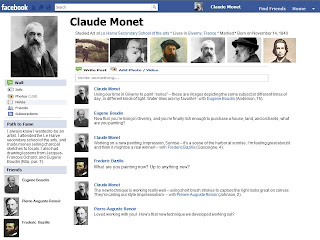Teaching Primary Source Documents in ELA: The best fit?
| Above: A portion of my bookshelf |
This is a picture of my bookshelf. I was going for optimism when I labeled my binder for the Common Core Standards. Hearts and smiley faces make everything better, right?
Actually, to be honest, I don't hate the standards. I know I was pretty harsh on the text exemplars in my last post, but the standards do have a lot going for them.
Even though English teachers in my building are dismayed (and the word dismayed isn't hyperbole), I'm excited about certain aspects of the standards, especially the focus on informational texts.
At some point, I promise I'll talk about the GOOD aspects of the standards, but first, I think some clarification is in order.
In my previous post, I implied that the text exemplars weren't a prescribed reading list, citing this from Appendix B: "They expressly do not represent a a partial or complete reading list" (2). I interpreted this to mean that "we" (the state? the district? the individual teacher?) could select any and all appropriate readings.
After further investigation, I think the quote from Appendix B is misleading. When you explore the supporting documents, you realize that some items from the text exemplars ARE a prescribed reading list (at least a partial one). For example, the document "Myths v. Facts About the Common Core Standards" says:
"In English-language arts, the Standards require certain critical content for all students, including: classic myths and stories from around the world, America's Founding documents, foundational American literature, and Shakespeare" (1).
If you look at the standards themselves, you find examples like the following from the 9th grade ELA standards:
"Analyze seminal U.S. documents of historical and literary significance (e.g., Washington's Farewell Address, the Gettysburg Address, Roosevelt's Four Freedoms speech, King's 'Letter from Birmingham Jail'), including how they address related themes and concepts" (RI.9-10.9).
And this, from the 11th-12th grade ELA standards:
"Demonstrate knowledge of eighteenth-, nineteenth- and early-twentieth-century foundational works of American literature, including how two or more texts from the same period treat similar themes or topics" (RL.11-12.9).
From what I can tell, the REQUIRED content of "classic myths and stories from around the world" occurs at the K-8 level in the Standards, while the REQUIRED content of "America's Founding documents, foundational American literature, and Shakespeare" occurs at the 9-12 level in the Standards. Keep in mind, though, that Appendix B exemplars include classic literature and seminal U.S. documents at MOST levels beyond the required content.
So, some items from the text exemplars ARE prescribed.
Now that that's cleared up (?), let's look more closely at the ELA informational texts requirement and their focus on primary source documents.
Primary source documents are GREAT. I totally believe students should be using them to inform their research, but is an ELA classroom the best place to read primary source documents? The text exemplars in Appendix B list five informational ELA texts for Grades 6-8. Four of the five texts are primary source documents from American history (this includes a letter by John Adams, Frederick Douglass' narrative, Winston Churchill's address, and John Steinbeck's tour of America).
Does it really make sense to teach these primary source documents in an ELA classroom? ELA teachers can't possibly devote the necessary class time and energy needed to firmly ground the documents in their historical context. It's MUCH MORE LOGICAL to have students explore primary source documents in their Social Studies classrooms within the framework of an appropriate unit.
Oddly, the text exemplars don't suggest students read primary source informational texts in their History/Social Studies classroom. (Remember, Common Core Standards currently exist for ELA and Math -- other subject areas, like History, and Science are just supposed to "focus" on reading and writing within their subject areas, but are not given specific standards, though Common Core has provided text exemplars for these subject areas to indicate what kind of texts they're expected to include).
There are eight suggested texts in the 6th-8th grade History/Social Studies informational text strand, and out of these eight, only one (the Constitution's Preamble and the First Amendment) is a primary source document. The rest of the informational texts are well-chosen, modern, engaging accounts of history (Side note: where are the engaging, modern informational texts in the ELA exemplars?).
Why are the standards asking us to teach America History primary source documents in ELA and not in Social Studies? How does that make sense? Can anyone clarify this for me?



In my understanding, the focus on the U.S. documents should be rhetorical. Yes, there will have to be some information that students must understand historically to put the text in context, but we do that for other pieces of literature we teach anyway. My plan will be to give a basic context of where the piece fits historically and then focus on the rhethorical analysis. The rhetorical analysis ties in with goals and skills of argumentative writing. My biggest challenge is trying to tie these documents in with other texts so that they will flow with the units instead of standing alone. CCSS are a challenge, but one that allows us to reconsider what we teach and why. Best wishes on your adventure. I enjoyed reading your post.
ReplyDeleteThere are hundreds of nonfiction high-interest texts out there. We should build a list that will support the new standards. I think these standards are rigorous and I look forward to implementing them in my classroom. Remember, these are standards, not benchmarks.
ReplyDeleteSorry, I should have posted this earlier:
ReplyDeletehttp://www.librarygirl.net/2012/02/ive-been-thinking-lot-about-content.html